Physical Logistic and Distribution: Tesco Supply Chain Report
VerifiedAdded on 2021/05/31
|15
|3066
|34
Report
AI Summary
This report provides an in-depth analysis of physical logistics and distribution, with a specific focus on Tesco's supply chain management. It begins with an introduction to logistics and distribution, emphasizing their role in the supply chain and the importance of effective management for achieving a competitive advantage. The report then examines Tesco's supply chain, detailing its initiatives, including sale scanning points, automated warehouse control, and centralized ordering. It also discusses Tesco's use of technologies like RFID. The report further explores current trends and issues in supply chain processes, such as demand-driven focus, globalization, increasing competition, outsourcing, and the impact of complex product life cycles. It highlights the advantages and disadvantages of these trends and their implications for companies like Tesco. The report concludes by outlining the key processes within the global supply chain, including customer relationship management, demand management, and logistics, providing insights into how these processes interrelate and contribute to the overall efficiency of the supply chain. The report also discusses the logistics process planning and associated business processes.
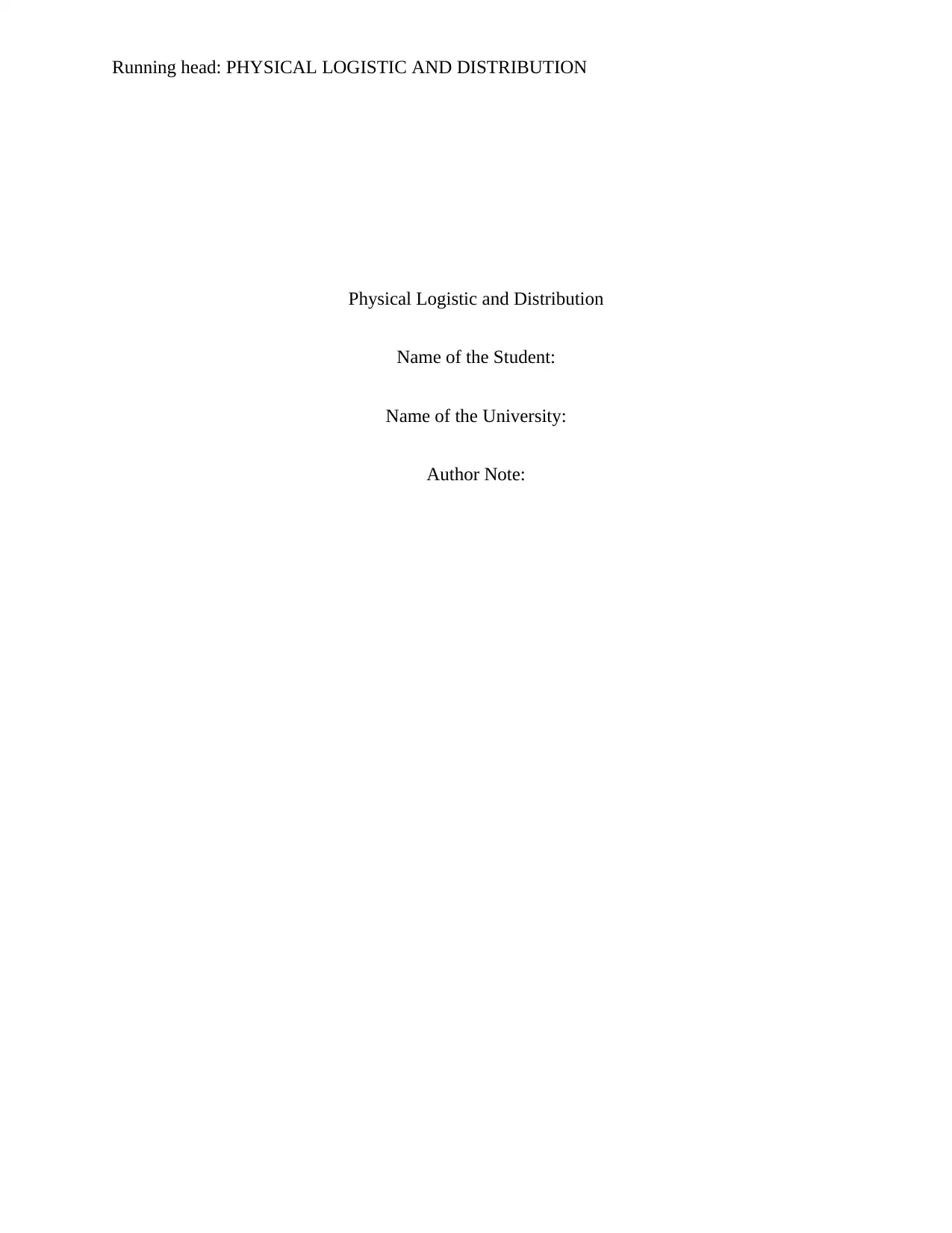
Running head: PHYSICAL LOGISTIC AND DISTRIBUTION
Physical Logistic and Distribution
Name of the Student:
Name of the University:
Author Note:
Physical Logistic and Distribution
Name of the Student:
Name of the University:
Author Note:
Paraphrase This Document
Need a fresh take? Get an instant paraphrase of this document with our AI Paraphraser
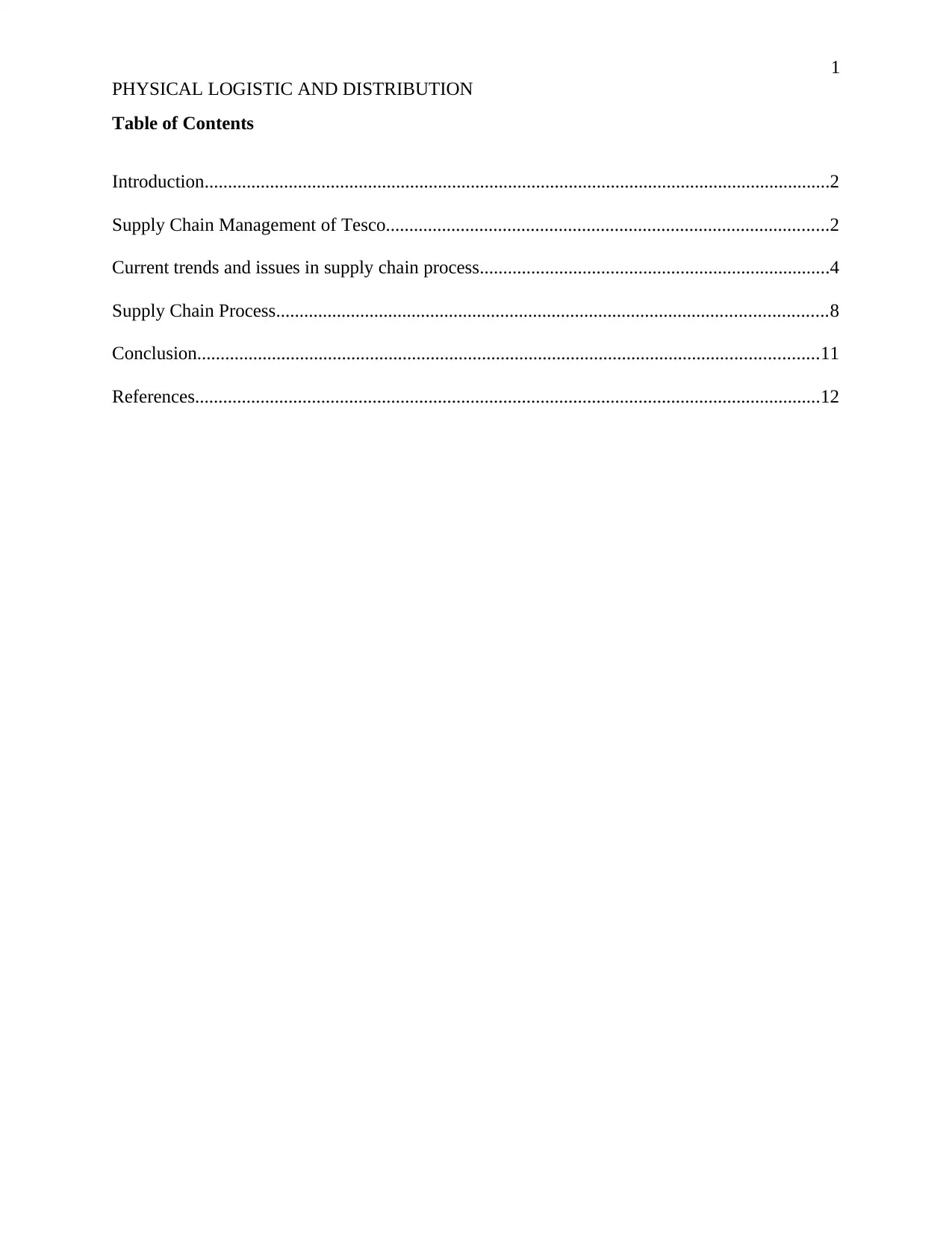
1
PHYSICAL LOGISTIC AND DISTRIBUTION
Table of Contents
Introduction......................................................................................................................................2
Supply Chain Management of Tesco...............................................................................................2
Current trends and issues in supply chain process...........................................................................4
Supply Chain Process......................................................................................................................8
Conclusion.....................................................................................................................................11
References......................................................................................................................................12
PHYSICAL LOGISTIC AND DISTRIBUTION
Table of Contents
Introduction......................................................................................................................................2
Supply Chain Management of Tesco...............................................................................................2
Current trends and issues in supply chain process...........................................................................4
Supply Chain Process......................................................................................................................8
Conclusion.....................................................................................................................................11
References......................................................................................................................................12
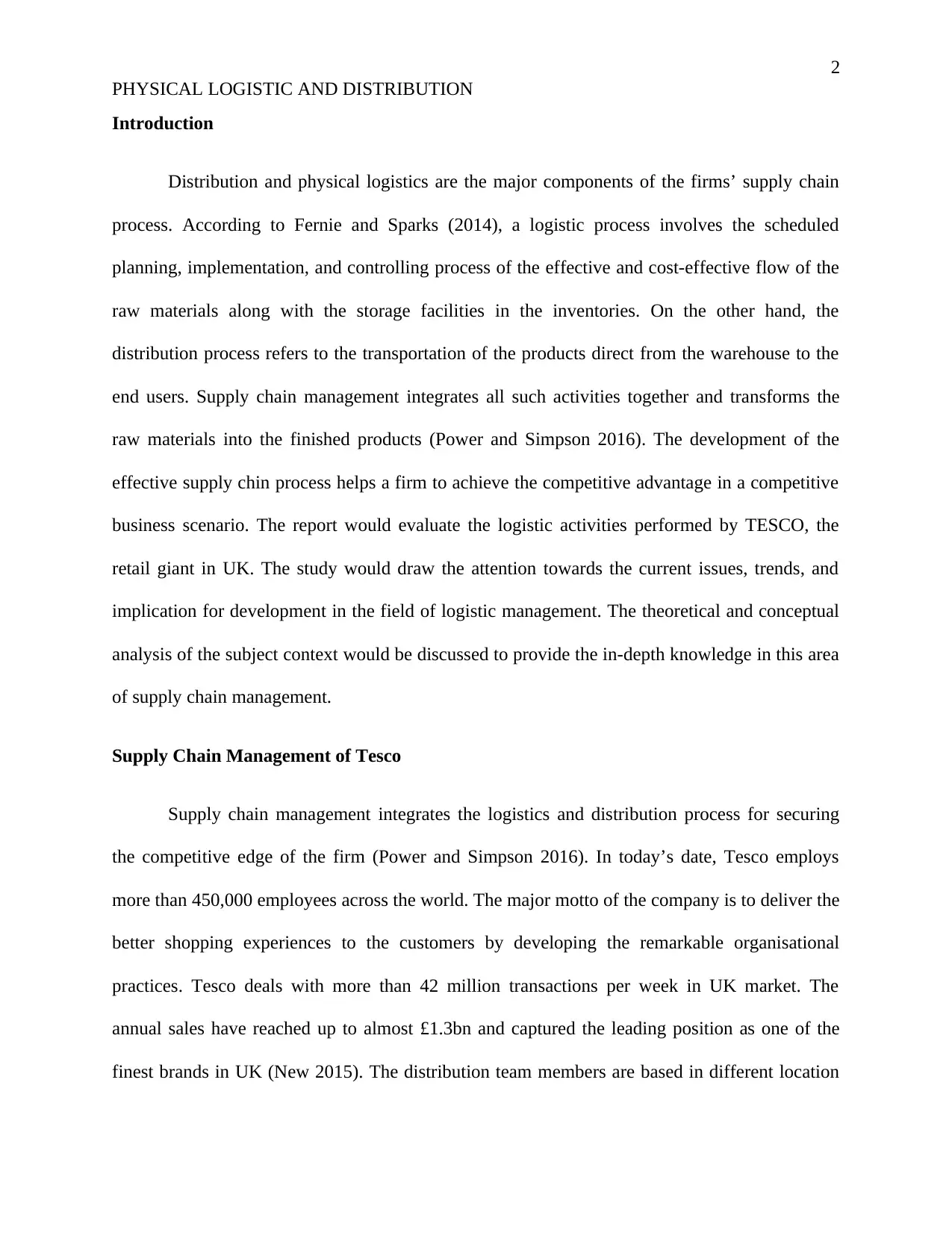
2
PHYSICAL LOGISTIC AND DISTRIBUTION
Introduction
Distribution and physical logistics are the major components of the firms’ supply chain
process. According to Fernie and Sparks (2014), a logistic process involves the scheduled
planning, implementation, and controlling process of the effective and cost-effective flow of the
raw materials along with the storage facilities in the inventories. On the other hand, the
distribution process refers to the transportation of the products direct from the warehouse to the
end users. Supply chain management integrates all such activities together and transforms the
raw materials into the finished products (Power and Simpson 2016). The development of the
effective supply chin process helps a firm to achieve the competitive advantage in a competitive
business scenario. The report would evaluate the logistic activities performed by TESCO, the
retail giant in UK. The study would draw the attention towards the current issues, trends, and
implication for development in the field of logistic management. The theoretical and conceptual
analysis of the subject context would be discussed to provide the in-depth knowledge in this area
of supply chain management.
Supply Chain Management of Tesco
Supply chain management integrates the logistics and distribution process for securing
the competitive edge of the firm (Power and Simpson 2016). In today’s date, Tesco employs
more than 450,000 employees across the world. The major motto of the company is to deliver the
better shopping experiences to the customers by developing the remarkable organisational
practices. Tesco deals with more than 42 million transactions per week in UK market. The
annual sales have reached up to almost £1.3bn and captured the leading position as one of the
finest brands in UK (New 2015). The distribution team members are based in different location
PHYSICAL LOGISTIC AND DISTRIBUTION
Introduction
Distribution and physical logistics are the major components of the firms’ supply chain
process. According to Fernie and Sparks (2014), a logistic process involves the scheduled
planning, implementation, and controlling process of the effective and cost-effective flow of the
raw materials along with the storage facilities in the inventories. On the other hand, the
distribution process refers to the transportation of the products direct from the warehouse to the
end users. Supply chain management integrates all such activities together and transforms the
raw materials into the finished products (Power and Simpson 2016). The development of the
effective supply chin process helps a firm to achieve the competitive advantage in a competitive
business scenario. The report would evaluate the logistic activities performed by TESCO, the
retail giant in UK. The study would draw the attention towards the current issues, trends, and
implication for development in the field of logistic management. The theoretical and conceptual
analysis of the subject context would be discussed to provide the in-depth knowledge in this area
of supply chain management.
Supply Chain Management of Tesco
Supply chain management integrates the logistics and distribution process for securing
the competitive edge of the firm (Power and Simpson 2016). In today’s date, Tesco employs
more than 450,000 employees across the world. The major motto of the company is to deliver the
better shopping experiences to the customers by developing the remarkable organisational
practices. Tesco deals with more than 42 million transactions per week in UK market. The
annual sales have reached up to almost £1.3bn and captured the leading position as one of the
finest brands in UK (New 2015). The distribution team members are based in different location
⊘ This is a preview!⊘
Do you want full access?
Subscribe today to unlock all pages.

Trusted by 1+ million students worldwide
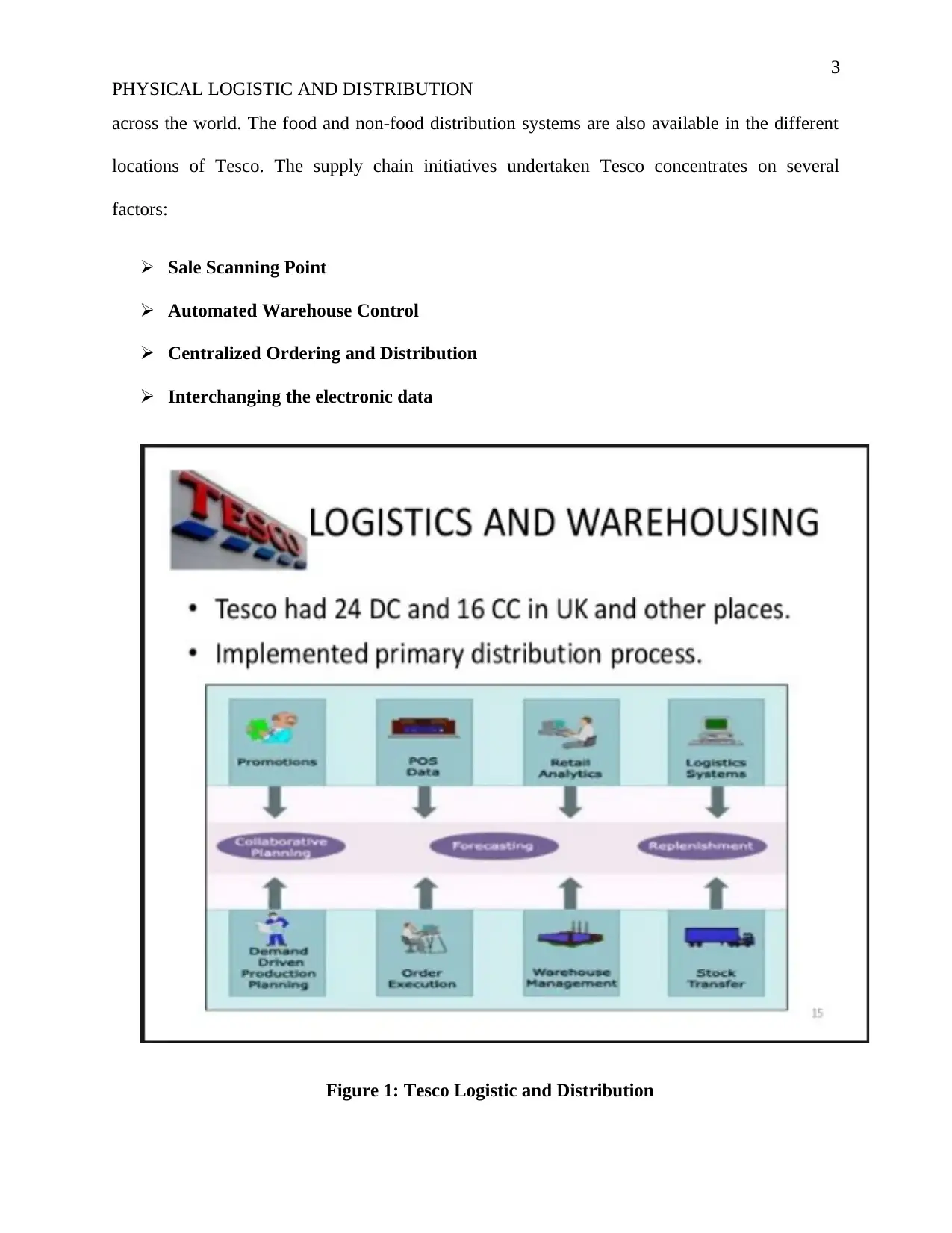
3
PHYSICAL LOGISTIC AND DISTRIBUTION
across the world. The food and non-food distribution systems are also available in the different
locations of Tesco. The supply chain initiatives undertaken Tesco concentrates on several
factors:
Sale Scanning Point
Automated Warehouse Control
Centralized Ordering and Distribution
Interchanging the electronic data
Figure 1: Tesco Logistic and Distribution
PHYSICAL LOGISTIC AND DISTRIBUTION
across the world. The food and non-food distribution systems are also available in the different
locations of Tesco. The supply chain initiatives undertaken Tesco concentrates on several
factors:
Sale Scanning Point
Automated Warehouse Control
Centralized Ordering and Distribution
Interchanging the electronic data
Figure 1: Tesco Logistic and Distribution
Paraphrase This Document
Need a fresh take? Get an instant paraphrase of this document with our AI Paraphraser
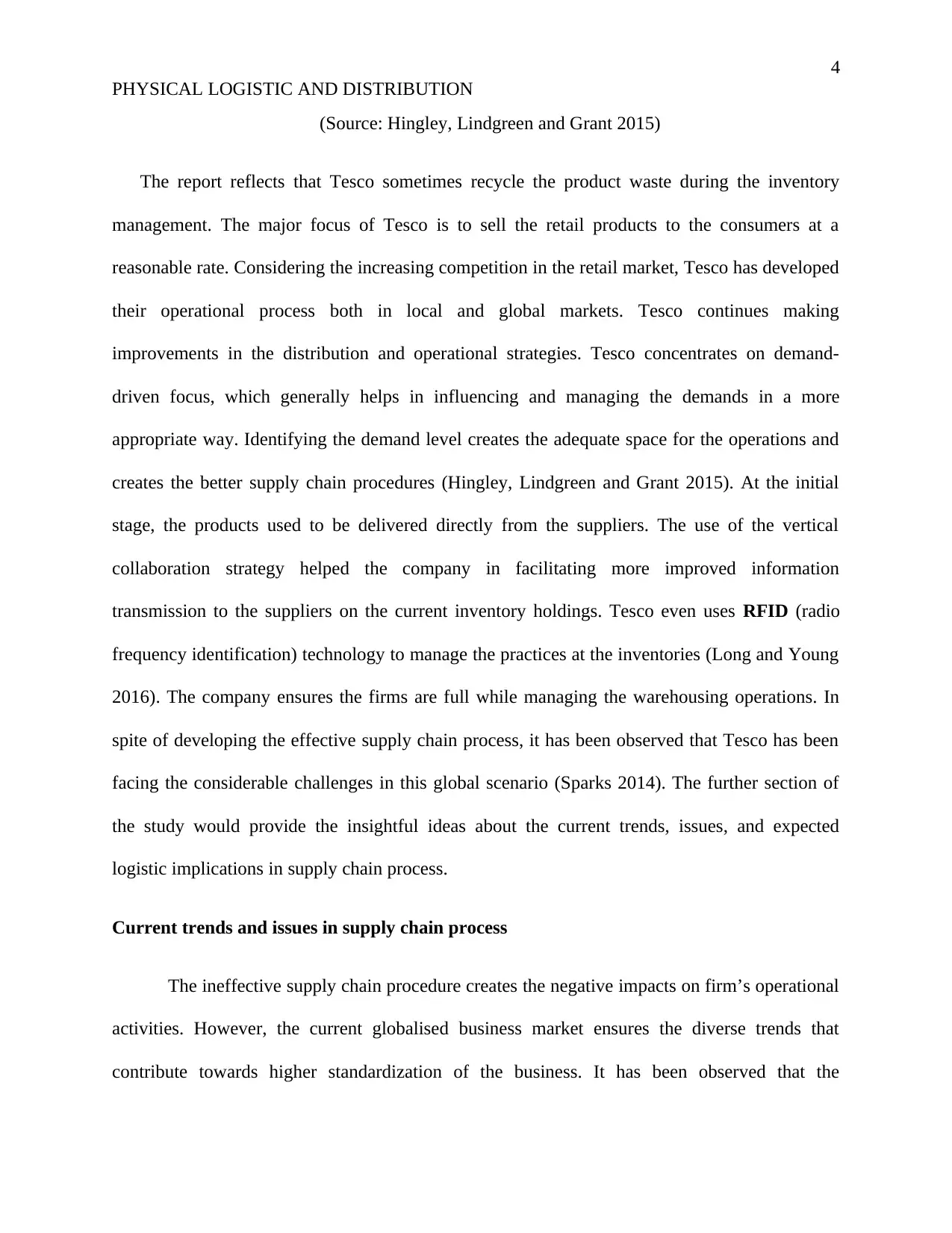
4
PHYSICAL LOGISTIC AND DISTRIBUTION
(Source: Hingley, Lindgreen and Grant 2015)
The report reflects that Tesco sometimes recycle the product waste during the inventory
management. The major focus of Tesco is to sell the retail products to the consumers at a
reasonable rate. Considering the increasing competition in the retail market, Tesco has developed
their operational process both in local and global markets. Tesco continues making
improvements in the distribution and operational strategies. Tesco concentrates on demand-
driven focus, which generally helps in influencing and managing the demands in a more
appropriate way. Identifying the demand level creates the adequate space for the operations and
creates the better supply chain procedures (Hingley, Lindgreen and Grant 2015). At the initial
stage, the products used to be delivered directly from the suppliers. The use of the vertical
collaboration strategy helped the company in facilitating more improved information
transmission to the suppliers on the current inventory holdings. Tesco even uses RFID (radio
frequency identification) technology to manage the practices at the inventories (Long and Young
2016). The company ensures the firms are full while managing the warehousing operations. In
spite of developing the effective supply chain process, it has been observed that Tesco has been
facing the considerable challenges in this global scenario (Sparks 2014). The further section of
the study would provide the insightful ideas about the current trends, issues, and expected
logistic implications in supply chain process.
Current trends and issues in supply chain process
The ineffective supply chain procedure creates the negative impacts on firm’s operational
activities. However, the current globalised business market ensures the diverse trends that
contribute towards higher standardization of the business. It has been observed that the
PHYSICAL LOGISTIC AND DISTRIBUTION
(Source: Hingley, Lindgreen and Grant 2015)
The report reflects that Tesco sometimes recycle the product waste during the inventory
management. The major focus of Tesco is to sell the retail products to the consumers at a
reasonable rate. Considering the increasing competition in the retail market, Tesco has developed
their operational process both in local and global markets. Tesco continues making
improvements in the distribution and operational strategies. Tesco concentrates on demand-
driven focus, which generally helps in influencing and managing the demands in a more
appropriate way. Identifying the demand level creates the adequate space for the operations and
creates the better supply chain procedures (Hingley, Lindgreen and Grant 2015). At the initial
stage, the products used to be delivered directly from the suppliers. The use of the vertical
collaboration strategy helped the company in facilitating more improved information
transmission to the suppliers on the current inventory holdings. Tesco even uses RFID (radio
frequency identification) technology to manage the practices at the inventories (Long and Young
2016). The company ensures the firms are full while managing the warehousing operations. In
spite of developing the effective supply chain process, it has been observed that Tesco has been
facing the considerable challenges in this global scenario (Sparks 2014). The further section of
the study would provide the insightful ideas about the current trends, issues, and expected
logistic implications in supply chain process.
Current trends and issues in supply chain process
The ineffective supply chain procedure creates the negative impacts on firm’s operational
activities. However, the current globalised business market ensures the diverse trends that
contribute towards higher standardization of the business. It has been observed that the
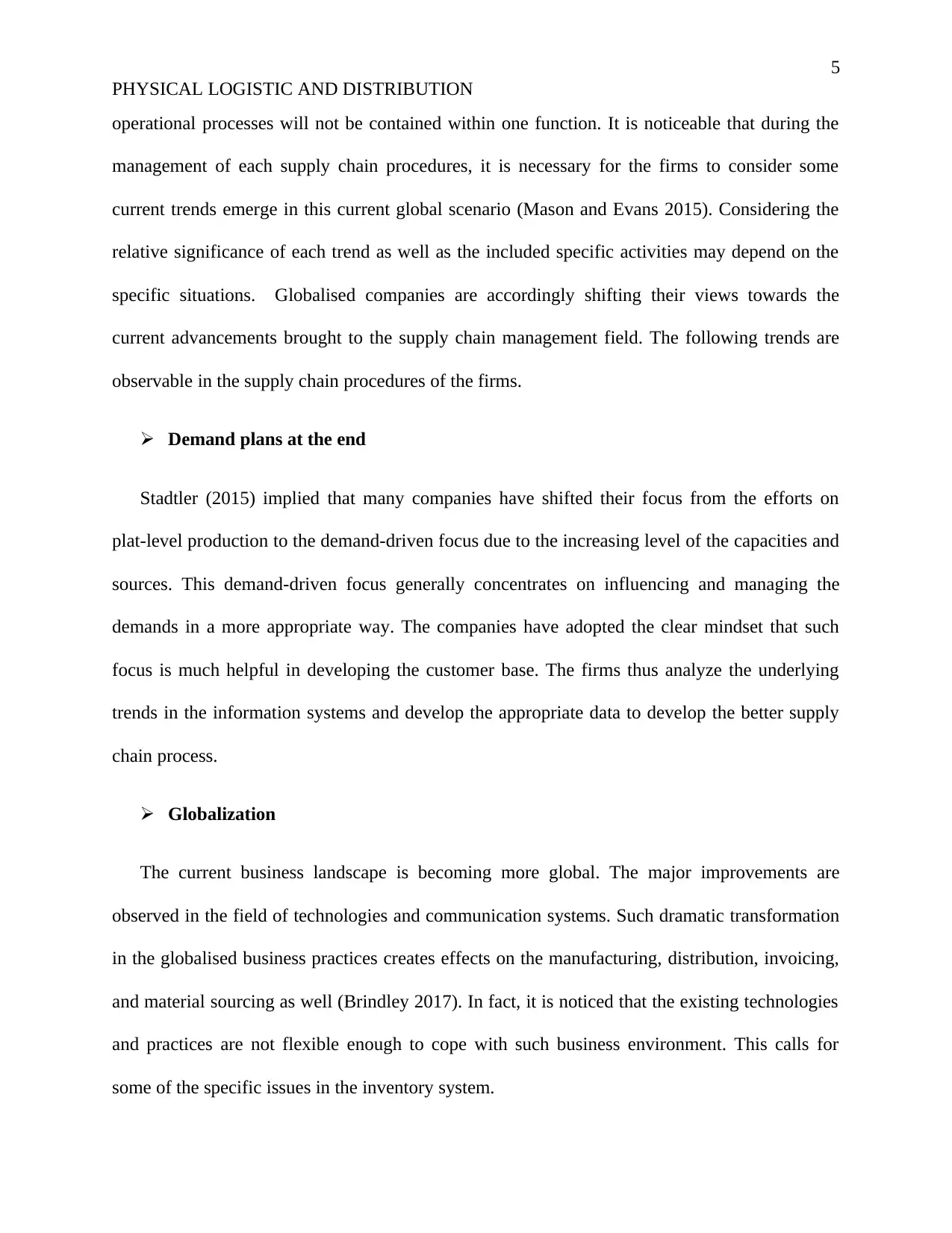
5
PHYSICAL LOGISTIC AND DISTRIBUTION
operational processes will not be contained within one function. It is noticeable that during the
management of each supply chain procedures, it is necessary for the firms to consider some
current trends emerge in this current global scenario (Mason and Evans 2015). Considering the
relative significance of each trend as well as the included specific activities may depend on the
specific situations. Globalised companies are accordingly shifting their views towards the
current advancements brought to the supply chain management field. The following trends are
observable in the supply chain procedures of the firms.
Demand plans at the end
Stadtler (2015) implied that many companies have shifted their focus from the efforts on
plat-level production to the demand-driven focus due to the increasing level of the capacities and
sources. This demand-driven focus generally concentrates on influencing and managing the
demands in a more appropriate way. The companies have adopted the clear mindset that such
focus is much helpful in developing the customer base. The firms thus analyze the underlying
trends in the information systems and develop the appropriate data to develop the better supply
chain process.
Globalization
The current business landscape is becoming more global. The major improvements are
observed in the field of technologies and communication systems. Such dramatic transformation
in the globalised business practices creates effects on the manufacturing, distribution, invoicing,
and material sourcing as well (Brindley 2017). In fact, it is noticed that the existing technologies
and practices are not flexible enough to cope with such business environment. This calls for
some of the specific issues in the inventory system.
PHYSICAL LOGISTIC AND DISTRIBUTION
operational processes will not be contained within one function. It is noticeable that during the
management of each supply chain procedures, it is necessary for the firms to consider some
current trends emerge in this current global scenario (Mason and Evans 2015). Considering the
relative significance of each trend as well as the included specific activities may depend on the
specific situations. Globalised companies are accordingly shifting their views towards the
current advancements brought to the supply chain management field. The following trends are
observable in the supply chain procedures of the firms.
Demand plans at the end
Stadtler (2015) implied that many companies have shifted their focus from the efforts on
plat-level production to the demand-driven focus due to the increasing level of the capacities and
sources. This demand-driven focus generally concentrates on influencing and managing the
demands in a more appropriate way. The companies have adopted the clear mindset that such
focus is much helpful in developing the customer base. The firms thus analyze the underlying
trends in the information systems and develop the appropriate data to develop the better supply
chain process.
Globalization
The current business landscape is becoming more global. The major improvements are
observed in the field of technologies and communication systems. Such dramatic transformation
in the globalised business practices creates effects on the manufacturing, distribution, invoicing,
and material sourcing as well (Brindley 2017). In fact, it is noticed that the existing technologies
and practices are not flexible enough to cope with such business environment. This calls for
some of the specific issues in the inventory system.
⊘ This is a preview!⊘
Do you want full access?
Subscribe today to unlock all pages.

Trusted by 1+ million students worldwide
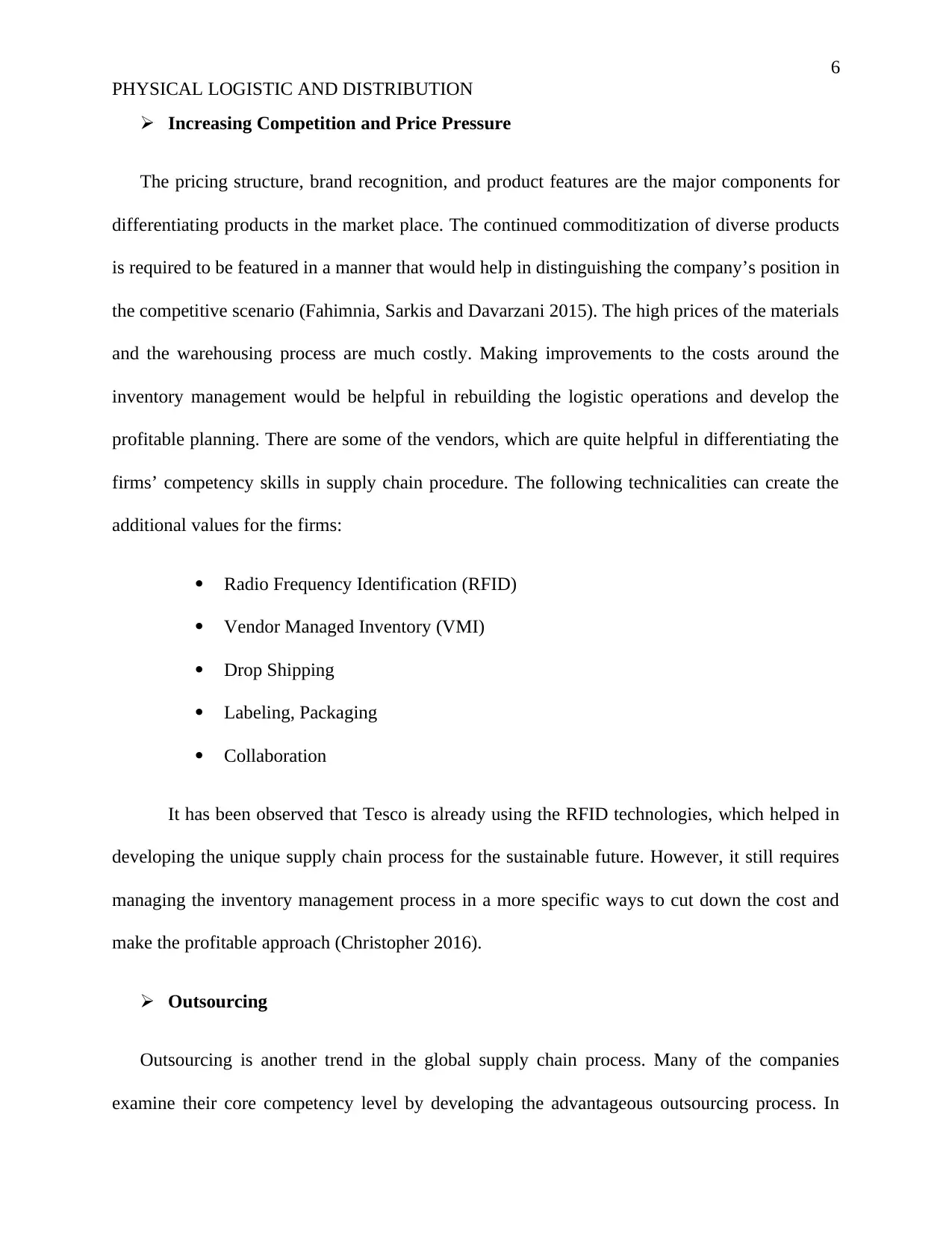
6
PHYSICAL LOGISTIC AND DISTRIBUTION
Increasing Competition and Price Pressure
The pricing structure, brand recognition, and product features are the major components for
differentiating products in the market place. The continued commoditization of diverse products
is required to be featured in a manner that would help in distinguishing the company’s position in
the competitive scenario (Fahimnia, Sarkis and Davarzani 2015). The high prices of the materials
and the warehousing process are much costly. Making improvements to the costs around the
inventory management would be helpful in rebuilding the logistic operations and develop the
profitable planning. There are some of the vendors, which are quite helpful in differentiating the
firms’ competency skills in supply chain procedure. The following technicalities can create the
additional values for the firms:
Radio Frequency Identification (RFID)
Vendor Managed Inventory (VMI)
Drop Shipping
Labeling, Packaging
Collaboration
It has been observed that Tesco is already using the RFID technologies, which helped in
developing the unique supply chain process for the sustainable future. However, it still requires
managing the inventory management process in a more specific ways to cut down the cost and
make the profitable approach (Christopher 2016).
Outsourcing
Outsourcing is another trend in the global supply chain process. Many of the companies
examine their core competency level by developing the advantageous outsourcing process. In
PHYSICAL LOGISTIC AND DISTRIBUTION
Increasing Competition and Price Pressure
The pricing structure, brand recognition, and product features are the major components for
differentiating products in the market place. The continued commoditization of diverse products
is required to be featured in a manner that would help in distinguishing the company’s position in
the competitive scenario (Fahimnia, Sarkis and Davarzani 2015). The high prices of the materials
and the warehousing process are much costly. Making improvements to the costs around the
inventory management would be helpful in rebuilding the logistic operations and develop the
profitable planning. There are some of the vendors, which are quite helpful in differentiating the
firms’ competency skills in supply chain procedure. The following technicalities can create the
additional values for the firms:
Radio Frequency Identification (RFID)
Vendor Managed Inventory (VMI)
Drop Shipping
Labeling, Packaging
Collaboration
It has been observed that Tesco is already using the RFID technologies, which helped in
developing the unique supply chain process for the sustainable future. However, it still requires
managing the inventory management process in a more specific ways to cut down the cost and
make the profitable approach (Christopher 2016).
Outsourcing
Outsourcing is another trend in the global supply chain process. Many of the companies
examine their core competency level by developing the advantageous outsourcing process. In
Paraphrase This Document
Need a fresh take? Get an instant paraphrase of this document with our AI Paraphraser
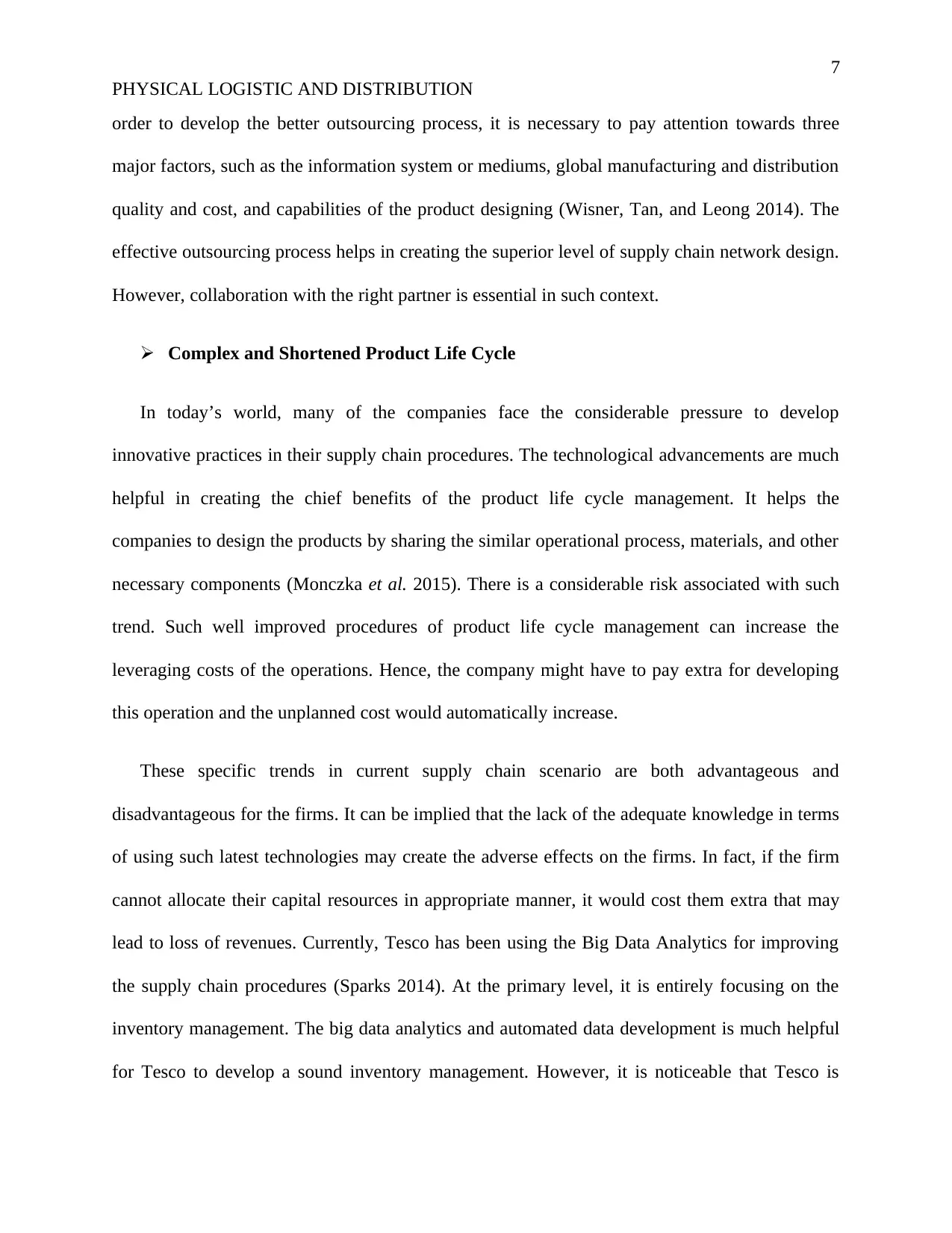
7
PHYSICAL LOGISTIC AND DISTRIBUTION
order to develop the better outsourcing process, it is necessary to pay attention towards three
major factors, such as the information system or mediums, global manufacturing and distribution
quality and cost, and capabilities of the product designing (Wisner, Tan, and Leong 2014). The
effective outsourcing process helps in creating the superior level of supply chain network design.
However, collaboration with the right partner is essential in such context.
Complex and Shortened Product Life Cycle
In today’s world, many of the companies face the considerable pressure to develop
innovative practices in their supply chain procedures. The technological advancements are much
helpful in creating the chief benefits of the product life cycle management. It helps the
companies to design the products by sharing the similar operational process, materials, and other
necessary components (Monczka et al. 2015). There is a considerable risk associated with such
trend. Such well improved procedures of product life cycle management can increase the
leveraging costs of the operations. Hence, the company might have to pay extra for developing
this operation and the unplanned cost would automatically increase.
These specific trends in current supply chain scenario are both advantageous and
disadvantageous for the firms. It can be implied that the lack of the adequate knowledge in terms
of using such latest technologies may create the adverse effects on the firms. In fact, if the firm
cannot allocate their capital resources in appropriate manner, it would cost them extra that may
lead to loss of revenues. Currently, Tesco has been using the Big Data Analytics for improving
the supply chain procedures (Sparks 2014). At the primary level, it is entirely focusing on the
inventory management. The big data analytics and automated data development is much helpful
for Tesco to develop a sound inventory management. However, it is noticeable that Tesco is
PHYSICAL LOGISTIC AND DISTRIBUTION
order to develop the better outsourcing process, it is necessary to pay attention towards three
major factors, such as the information system or mediums, global manufacturing and distribution
quality and cost, and capabilities of the product designing (Wisner, Tan, and Leong 2014). The
effective outsourcing process helps in creating the superior level of supply chain network design.
However, collaboration with the right partner is essential in such context.
Complex and Shortened Product Life Cycle
In today’s world, many of the companies face the considerable pressure to develop
innovative practices in their supply chain procedures. The technological advancements are much
helpful in creating the chief benefits of the product life cycle management. It helps the
companies to design the products by sharing the similar operational process, materials, and other
necessary components (Monczka et al. 2015). There is a considerable risk associated with such
trend. Such well improved procedures of product life cycle management can increase the
leveraging costs of the operations. Hence, the company might have to pay extra for developing
this operation and the unplanned cost would automatically increase.
These specific trends in current supply chain scenario are both advantageous and
disadvantageous for the firms. It can be implied that the lack of the adequate knowledge in terms
of using such latest technologies may create the adverse effects on the firms. In fact, if the firm
cannot allocate their capital resources in appropriate manner, it would cost them extra that may
lead to loss of revenues. Currently, Tesco has been using the Big Data Analytics for improving
the supply chain procedures (Sparks 2014). At the primary level, it is entirely focusing on the
inventory management. The big data analytics and automated data development is much helpful
for Tesco to develop a sound inventory management. However, it is noticeable that Tesco is
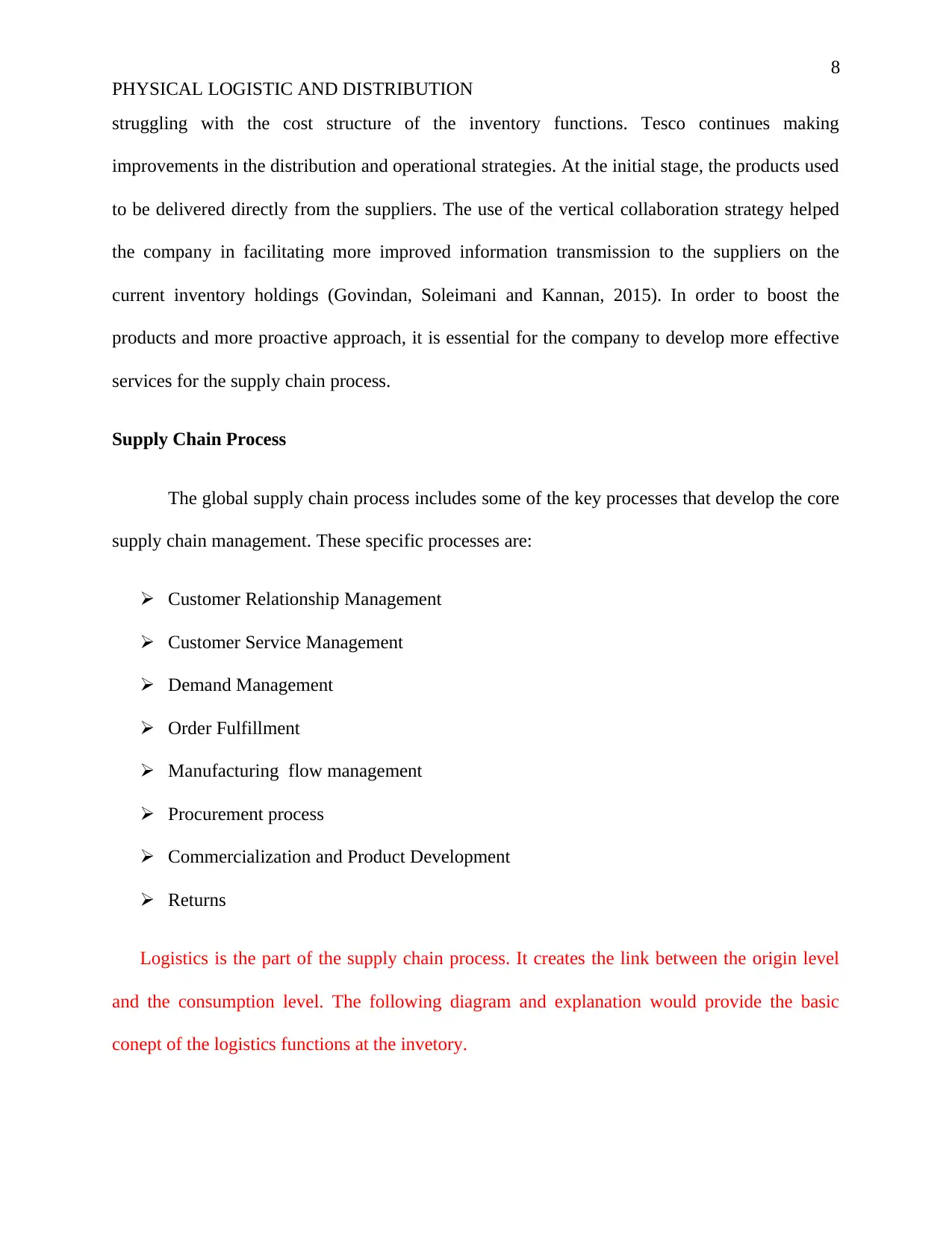
8
PHYSICAL LOGISTIC AND DISTRIBUTION
struggling with the cost structure of the inventory functions. Tesco continues making
improvements in the distribution and operational strategies. At the initial stage, the products used
to be delivered directly from the suppliers. The use of the vertical collaboration strategy helped
the company in facilitating more improved information transmission to the suppliers on the
current inventory holdings (Govindan, Soleimani and Kannan, 2015). In order to boost the
products and more proactive approach, it is essential for the company to develop more effective
services for the supply chain process.
Supply Chain Process
The global supply chain process includes some of the key processes that develop the core
supply chain management. These specific processes are:
Customer Relationship Management
Customer Service Management
Demand Management
Order Fulfillment
Manufacturing flow management
Procurement process
Commercialization and Product Development
Returns
Logistics is the part of the supply chain process. It creates the link between the origin level
and the consumption level. The following diagram and explanation would provide the basic
conept of the logistics functions at the invetory.
PHYSICAL LOGISTIC AND DISTRIBUTION
struggling with the cost structure of the inventory functions. Tesco continues making
improvements in the distribution and operational strategies. At the initial stage, the products used
to be delivered directly from the suppliers. The use of the vertical collaboration strategy helped
the company in facilitating more improved information transmission to the suppliers on the
current inventory holdings (Govindan, Soleimani and Kannan, 2015). In order to boost the
products and more proactive approach, it is essential for the company to develop more effective
services for the supply chain process.
Supply Chain Process
The global supply chain process includes some of the key processes that develop the core
supply chain management. These specific processes are:
Customer Relationship Management
Customer Service Management
Demand Management
Order Fulfillment
Manufacturing flow management
Procurement process
Commercialization and Product Development
Returns
Logistics is the part of the supply chain process. It creates the link between the origin level
and the consumption level. The following diagram and explanation would provide the basic
conept of the logistics functions at the invetory.
⊘ This is a preview!⊘
Do you want full access?
Subscribe today to unlock all pages.

Trusted by 1+ million students worldwide
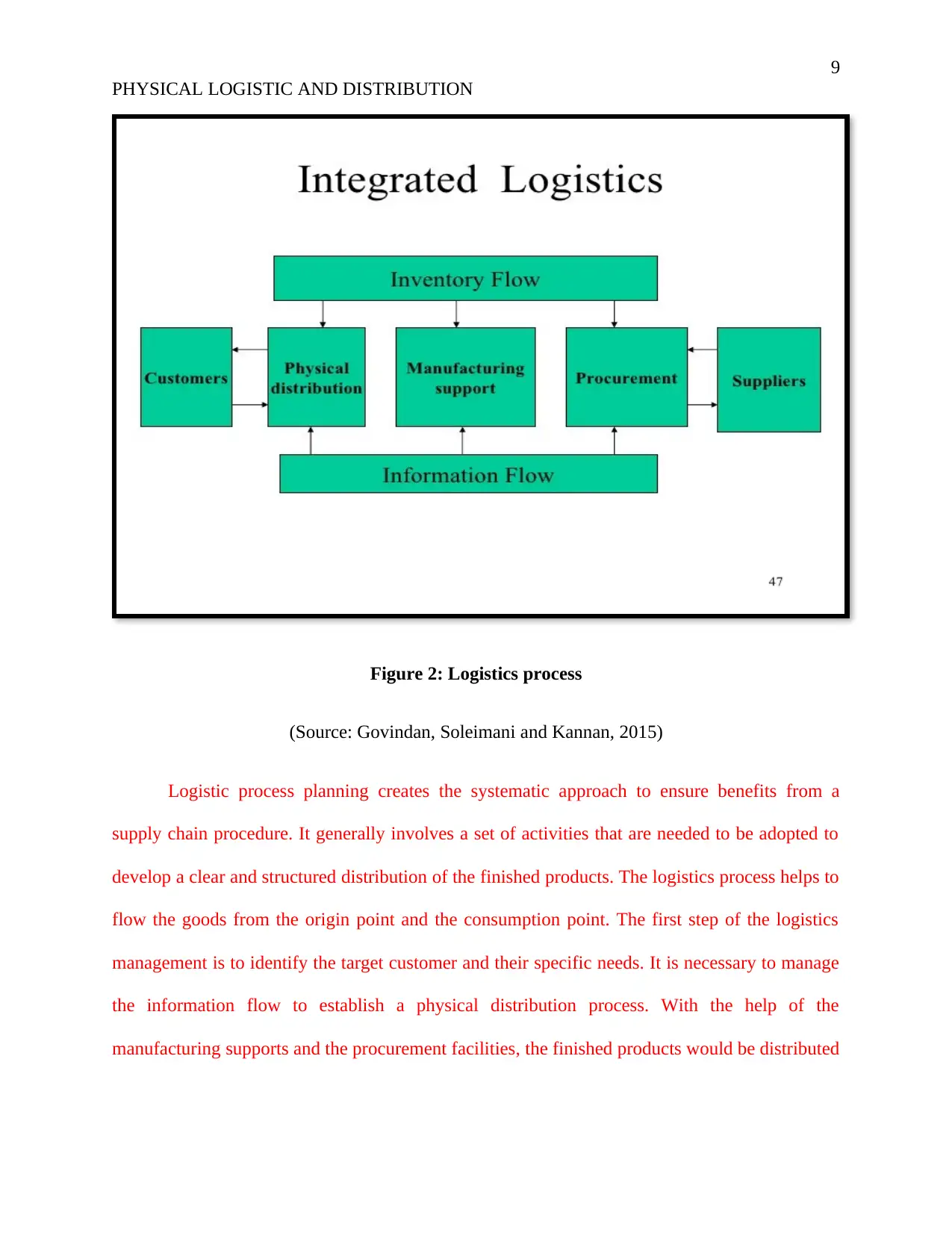
9
PHYSICAL LOGISTIC AND DISTRIBUTION
Figure 2: Logistics process
(Source: Govindan, Soleimani and Kannan, 2015)
Logistic process planning creates the systematic approach to ensure benefits from a
supply chain procedure. It generally involves a set of activities that are needed to be adopted to
develop a clear and structured distribution of the finished products. The logistics process helps to
flow the goods from the origin point and the consumption point. The first step of the logistics
management is to identify the target customer and their specific needs. It is necessary to manage
the information flow to establish a physical distribution process. With the help of the
manufacturing supports and the procurement facilities, the finished products would be distributed
PHYSICAL LOGISTIC AND DISTRIBUTION
Figure 2: Logistics process
(Source: Govindan, Soleimani and Kannan, 2015)
Logistic process planning creates the systematic approach to ensure benefits from a
supply chain procedure. It generally involves a set of activities that are needed to be adopted to
develop a clear and structured distribution of the finished products. The logistics process helps to
flow the goods from the origin point and the consumption point. The first step of the logistics
management is to identify the target customer and their specific needs. It is necessary to manage
the information flow to establish a physical distribution process. With the help of the
manufacturing supports and the procurement facilities, the finished products would be distributed
Paraphrase This Document
Need a fresh take? Get an instant paraphrase of this document with our AI Paraphraser
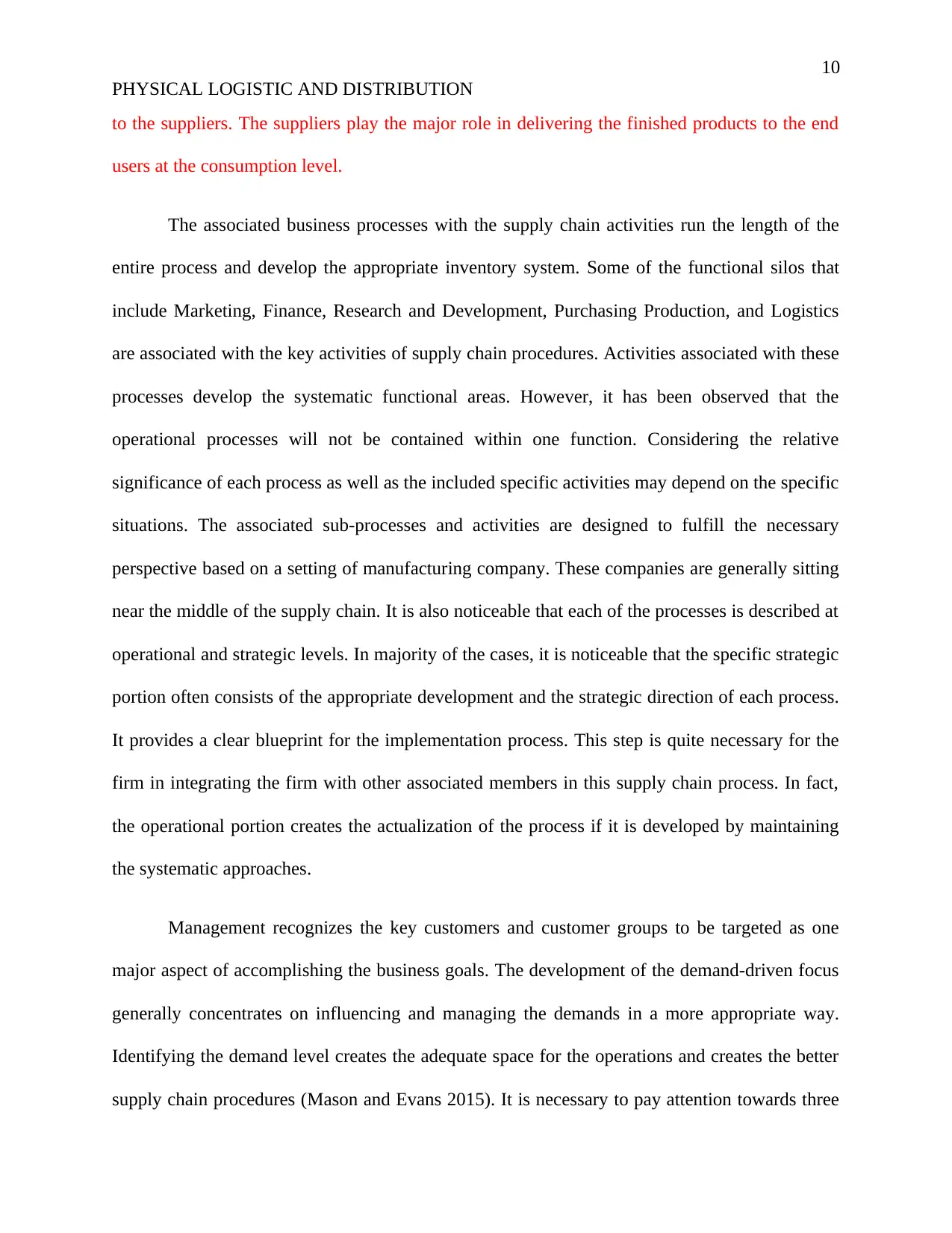
10
PHYSICAL LOGISTIC AND DISTRIBUTION
to the suppliers. The suppliers play the major role in delivering the finished products to the end
users at the consumption level.
The associated business processes with the supply chain activities run the length of the
entire process and develop the appropriate inventory system. Some of the functional silos that
include Marketing, Finance, Research and Development, Purchasing Production, and Logistics
are associated with the key activities of supply chain procedures. Activities associated with these
processes develop the systematic functional areas. However, it has been observed that the
operational processes will not be contained within one function. Considering the relative
significance of each process as well as the included specific activities may depend on the specific
situations. The associated sub-processes and activities are designed to fulfill the necessary
perspective based on a setting of manufacturing company. These companies are generally sitting
near the middle of the supply chain. It is also noticeable that each of the processes is described at
operational and strategic levels. In majority of the cases, it is noticeable that the specific strategic
portion often consists of the appropriate development and the strategic direction of each process.
It provides a clear blueprint for the implementation process. This step is quite necessary for the
firm in integrating the firm with other associated members in this supply chain process. In fact,
the operational portion creates the actualization of the process if it is developed by maintaining
the systematic approaches.
Management recognizes the key customers and customer groups to be targeted as one
major aspect of accomplishing the business goals. The development of the demand-driven focus
generally concentrates on influencing and managing the demands in a more appropriate way.
Identifying the demand level creates the adequate space for the operations and creates the better
supply chain procedures (Mason and Evans 2015). It is necessary to pay attention towards three
PHYSICAL LOGISTIC AND DISTRIBUTION
to the suppliers. The suppliers play the major role in delivering the finished products to the end
users at the consumption level.
The associated business processes with the supply chain activities run the length of the
entire process and develop the appropriate inventory system. Some of the functional silos that
include Marketing, Finance, Research and Development, Purchasing Production, and Logistics
are associated with the key activities of supply chain procedures. Activities associated with these
processes develop the systematic functional areas. However, it has been observed that the
operational processes will not be contained within one function. Considering the relative
significance of each process as well as the included specific activities may depend on the specific
situations. The associated sub-processes and activities are designed to fulfill the necessary
perspective based on a setting of manufacturing company. These companies are generally sitting
near the middle of the supply chain. It is also noticeable that each of the processes is described at
operational and strategic levels. In majority of the cases, it is noticeable that the specific strategic
portion often consists of the appropriate development and the strategic direction of each process.
It provides a clear blueprint for the implementation process. This step is quite necessary for the
firm in integrating the firm with other associated members in this supply chain process. In fact,
the operational portion creates the actualization of the process if it is developed by maintaining
the systematic approaches.
Management recognizes the key customers and customer groups to be targeted as one
major aspect of accomplishing the business goals. The development of the demand-driven focus
generally concentrates on influencing and managing the demands in a more appropriate way.
Identifying the demand level creates the adequate space for the operations and creates the better
supply chain procedures (Mason and Evans 2015). It is necessary to pay attention towards three
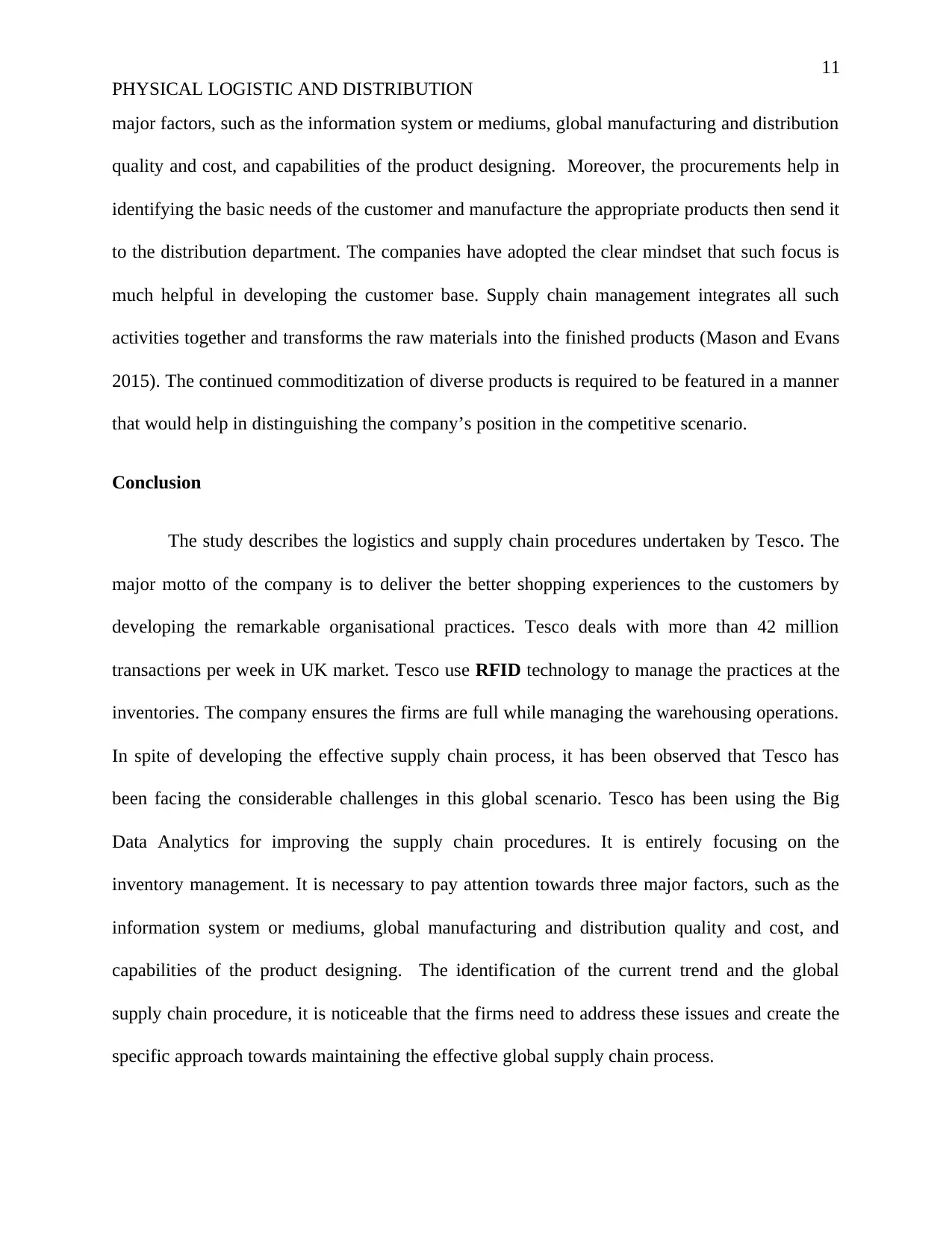
11
PHYSICAL LOGISTIC AND DISTRIBUTION
major factors, such as the information system or mediums, global manufacturing and distribution
quality and cost, and capabilities of the product designing. Moreover, the procurements help in
identifying the basic needs of the customer and manufacture the appropriate products then send it
to the distribution department. The companies have adopted the clear mindset that such focus is
much helpful in developing the customer base. Supply chain management integrates all such
activities together and transforms the raw materials into the finished products (Mason and Evans
2015). The continued commoditization of diverse products is required to be featured in a manner
that would help in distinguishing the company’s position in the competitive scenario.
Conclusion
The study describes the logistics and supply chain procedures undertaken by Tesco. The
major motto of the company is to deliver the better shopping experiences to the customers by
developing the remarkable organisational practices. Tesco deals with more than 42 million
transactions per week in UK market. Tesco use RFID technology to manage the practices at the
inventories. The company ensures the firms are full while managing the warehousing operations.
In spite of developing the effective supply chain process, it has been observed that Tesco has
been facing the considerable challenges in this global scenario. Tesco has been using the Big
Data Analytics for improving the supply chain procedures. It is entirely focusing on the
inventory management. It is necessary to pay attention towards three major factors, such as the
information system or mediums, global manufacturing and distribution quality and cost, and
capabilities of the product designing. The identification of the current trend and the global
supply chain procedure, it is noticeable that the firms need to address these issues and create the
specific approach towards maintaining the effective global supply chain process.
PHYSICAL LOGISTIC AND DISTRIBUTION
major factors, such as the information system or mediums, global manufacturing and distribution
quality and cost, and capabilities of the product designing. Moreover, the procurements help in
identifying the basic needs of the customer and manufacture the appropriate products then send it
to the distribution department. The companies have adopted the clear mindset that such focus is
much helpful in developing the customer base. Supply chain management integrates all such
activities together and transforms the raw materials into the finished products (Mason and Evans
2015). The continued commoditization of diverse products is required to be featured in a manner
that would help in distinguishing the company’s position in the competitive scenario.
Conclusion
The study describes the logistics and supply chain procedures undertaken by Tesco. The
major motto of the company is to deliver the better shopping experiences to the customers by
developing the remarkable organisational practices. Tesco deals with more than 42 million
transactions per week in UK market. Tesco use RFID technology to manage the practices at the
inventories. The company ensures the firms are full while managing the warehousing operations.
In spite of developing the effective supply chain process, it has been observed that Tesco has
been facing the considerable challenges in this global scenario. Tesco has been using the Big
Data Analytics for improving the supply chain procedures. It is entirely focusing on the
inventory management. It is necessary to pay attention towards three major factors, such as the
information system or mediums, global manufacturing and distribution quality and cost, and
capabilities of the product designing. The identification of the current trend and the global
supply chain procedure, it is noticeable that the firms need to address these issues and create the
specific approach towards maintaining the effective global supply chain process.
⊘ This is a preview!⊘
Do you want full access?
Subscribe today to unlock all pages.

Trusted by 1+ million students worldwide
1 out of 15
Related Documents
Your All-in-One AI-Powered Toolkit for Academic Success.
+13062052269
info@desklib.com
Available 24*7 on WhatsApp / Email
![[object Object]](/_next/static/media/star-bottom.7253800d.svg)
Unlock your academic potential
Copyright © 2020–2025 A2Z Services. All Rights Reserved. Developed and managed by ZUCOL.




